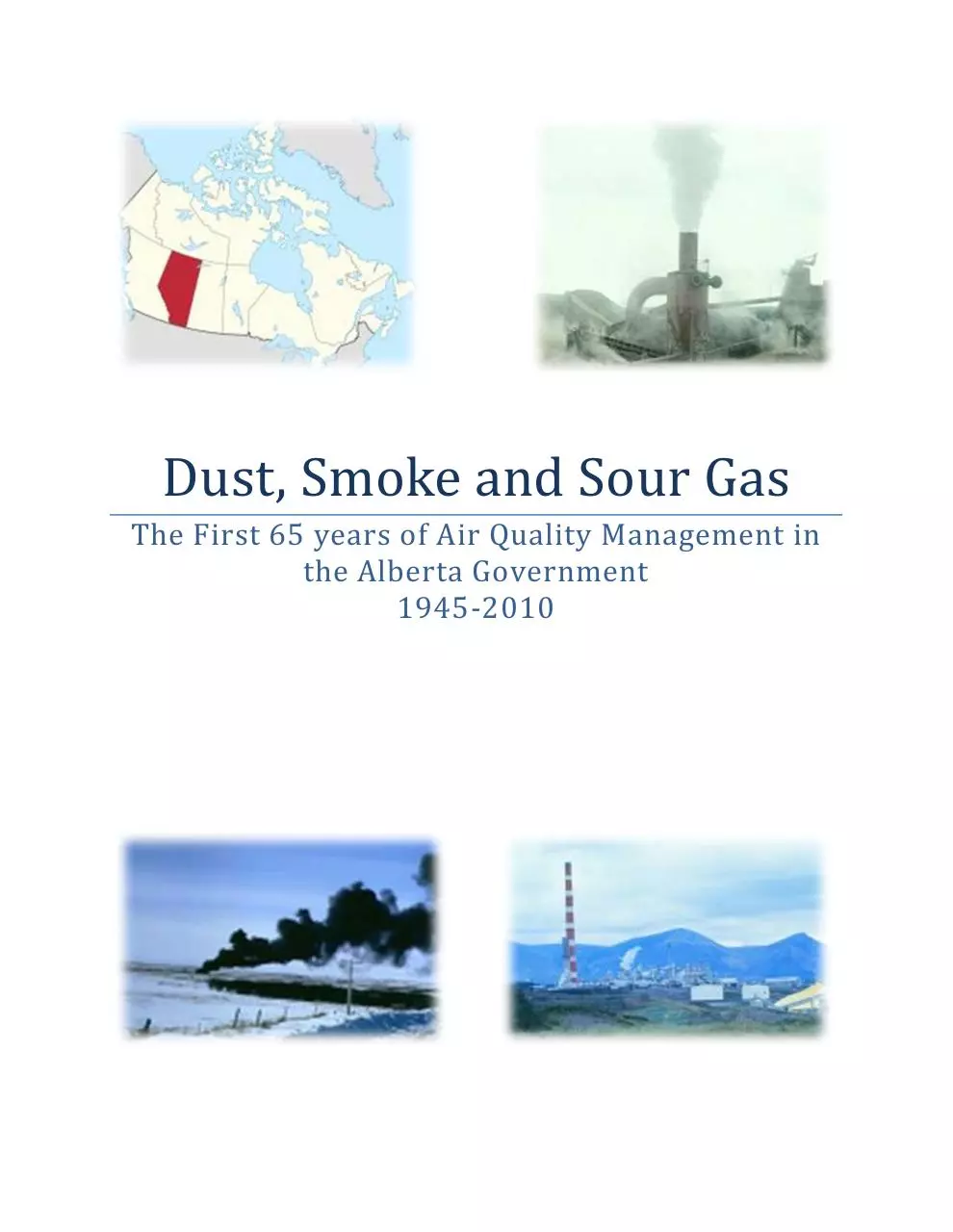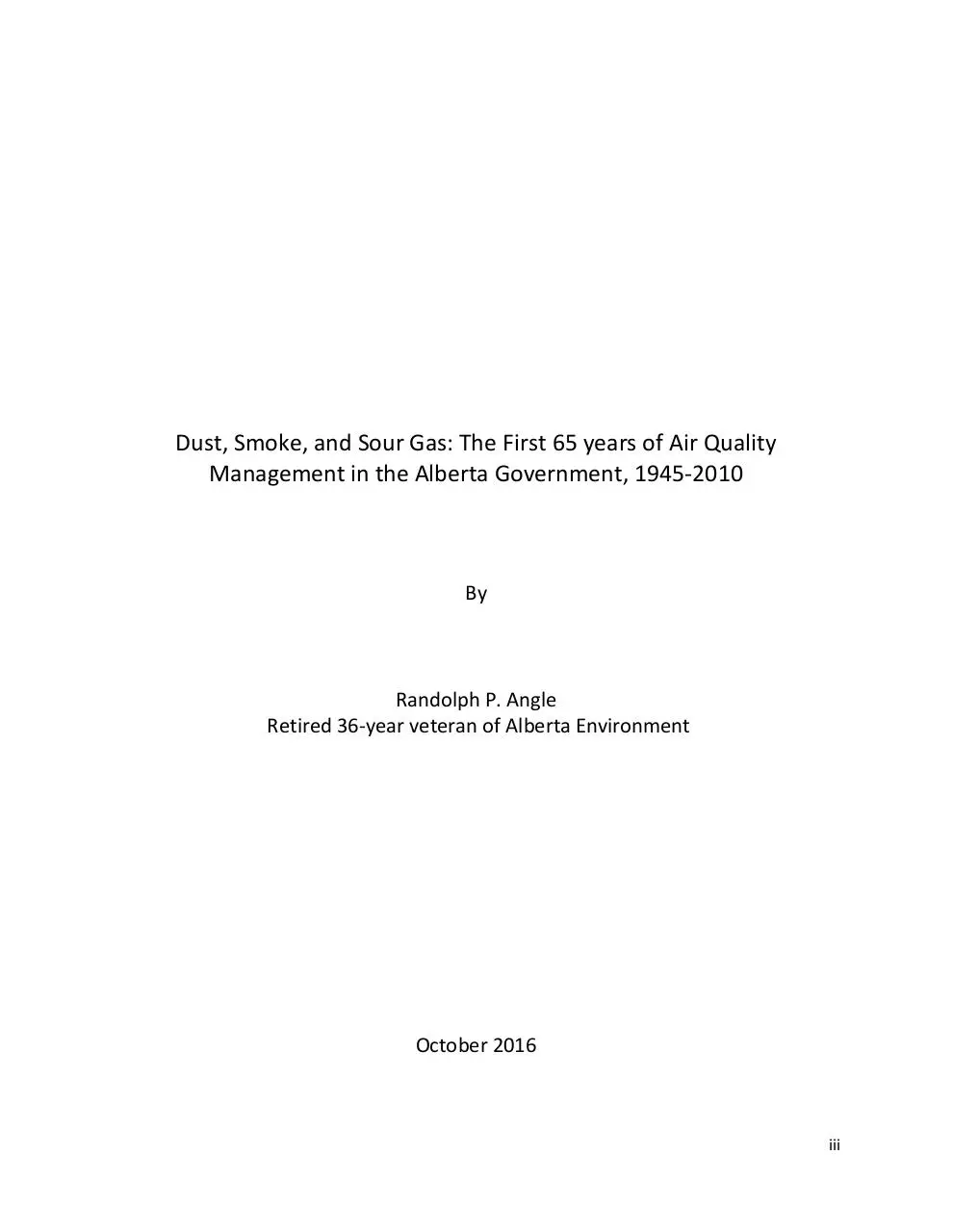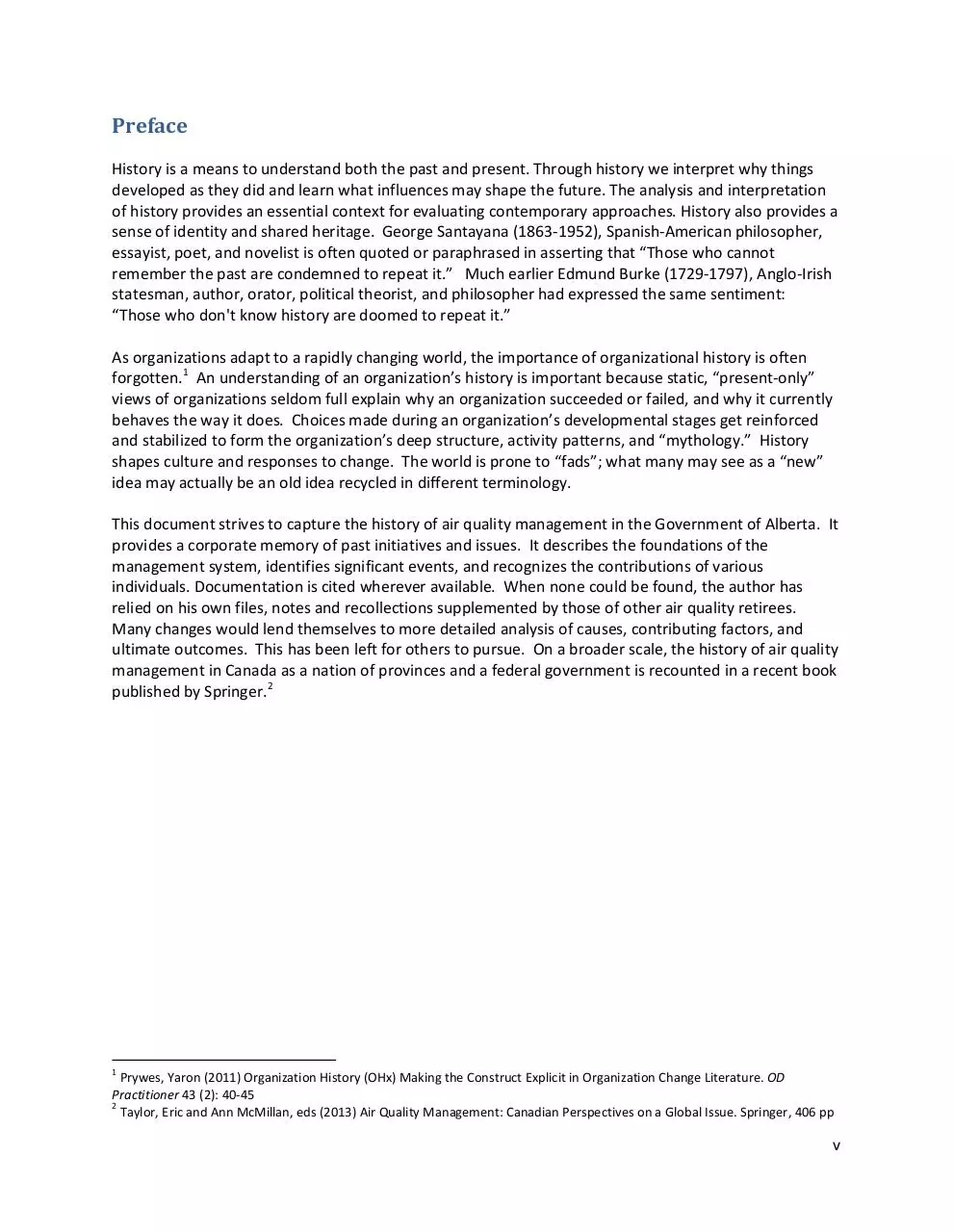Dust, Smoke and Sour Gas 19Oct2016 (PDF)
File information
Title: The History of Alberta Air Management Systems
Author: Randy Angle
This PDF 1.5 document has been generated by Acrobat PDFMaker 10.1 for Word / Adobe PDF Library 10.0, and has been sent on pdf-archive.com on 05/11/2016 at 18:15, from IP address 104.157.x.x.
The current document download page has been viewed 995 times.
File size: 6.47 MB (172 pages).
Privacy: public file





File preview
Dust, Smoke and Sour Gas
The First 65 years of Air Quality Management in
the Alberta Government
1945-2010
ii
Dust, Smoke, and Sour Gas: The First 65 years of Air Quality
Management in the Alberta Government, 1945-2010
By
Randolph P. Angle
Retired 36-year veteran of Alberta Environment
October 2016
iii
Dust, Smoke, and Sour Gas: The First 65 years of Air Quality Management in the
Alberta Government, 1945-2010 by Randolph P. Angle.
Copyright © 2016 by Randolph P. Angle. All rights reserved.
ISBN No. (pdf) 978-0-9953357-0-7
Except as permitted under the Canadian Copyright Act, no part of this publication
may be reproduced, distributed, or transmitted in any form or by any means, or
stored in a database or retrieval system, without the prior written permission of the
author (email: rangle2009@gmail.com).
While the author has used best efforts in preparing this book, no representations or
guarantees can be provided with respect to the completeness or accuracy of the
content. Mention of trade names or commercial products does not constitute
endorsement or recommendation.
iv
Preface
History is a means to understand both the past and present. Through history we interpret why things
developed as they did and learn what influences may shape the future. The analysis and interpretation
of history provides an essential context for evaluating contemporary approaches. History also provides a
sense of identity and shared heritage. George Santayana (1863-1952), Spanish-American philosopher,
essayist, poet, and novelist is often quoted or paraphrased in asserting that “Those who cannot
remember the past are condemned to repeat it.” Much earlier Edmund Burke (1729-1797), Anglo-Irish
statesman, author, orator, political theorist, and philosopher had expressed the same sentiment:
“Those who don't know history are doomed to repeat it.”
As organizations adapt to a rapidly changing world, the importance of organizational history is often
forgotten. 1 An understanding of an organization’s history is important because static, “present-only”
views of organizations seldom full explain why an organization succeeded or failed, and why it currently
behaves the way it does. Choices made during an organization’s developmental stages get reinforced
and stabilized to form the organization’s deep structure, activity patterns, and “mythology.” History
shapes culture and responses to change. The world is prone to “fads”; what many may see as a “new”
idea may actually be an old idea recycled in different terminology.
This document strives to capture the history of air quality management in the Government of Alberta. It
provides a corporate memory of past initiatives and issues. It describes the foundations of the
management system, identifies significant events, and recognizes the contributions of various
individuals. Documentation is cited wherever available. When none could be found, the author has
relied on his own files, notes and recollections supplemented by those of other air quality retirees.
Many changes would lend themselves to more detailed analysis of causes, contributing factors, and
ultimate outcomes. This has been left for others to pursue. On a broader scale, the history of air quality
management in Canada as a nation of provinces and a federal government is recounted in a recent book
published by Springer. 2
1
Prywes, Yaron (2011) Organization History (OHx) Making the Construct Explicit in Organization Change Literature. OD
Practitioner 43 (2): 40-45
2
Taylor, Eric and Ann McMillan, eds (2013) Air Quality Management: Canadian Perspectives on a Global Issue. Springer, 406 pp
v
Acknowledgements
The concept of an Alberta air management history originated with Chow Seng Liu in 2000 while he was
with the Air and Water Pollution Control Program of Alberta Environment. Chow Seng arranged a
meeting with some of the pioneers in the Department of Environment and collected some of the early
legislative materials. This prompted the author to begin collecting historical materials. The publication
of The Last Stack 3, the history of the first environmental consulting firm in Alberta, also stimulated
interest in the history of air management in Alberta. When Knowledge Management emerged briefly as
a corporate priority, in 2005/2006 the Systems Development Branch of Alberta Environment was able
to assign a student intern, Jennifer Martin, to the task of organizing the collection. Under the
supervision of Dr. Raymond Wong, she produced a spreadsheet of dates and events, together with a
covering narrative. Her work and report provided the starting point for this history.
The author retired from Alberta Environment in 2009, but was not able to work on the history until
2013. The Alberta Government Library, having absorbed the holdings of the old Alberta Environment
Library, proved to be a valuable resource, with at least one copy of documents not already in the
author’s collection. Additional information and input has been provided by a number of retired Alberta
Environment employees: Jerry Lack, Al Schulz, John Torneby, Chow Seng Liu, Ray Brassard, and Harry
Benders. Bill Calder reviewed the penultimate draft and made a number of valuable suggestions.
Special thanks go to Randy Dobko of the Air Policy Branch, Alberta Environment and Parks, for his
numerous contributions to this history. His personal document collection filled important gaps, his
memory enabled a fuller account of source standards, and his careful review caught a number of
mistakes in earlier drafts.
3
Stenson, Fred (2000) The Last Stack: Entrepreneurism and the Environment. CETAC-WEST, Calgary, AB. 367 pp
vi
Contents
Preface .......................................................................................................................................................... v
Acknowledgements...................................................................................................................................... vi
Figures .......................................................................................................................................................... ix
Tables ............................................................................................................................................................ x
Introduction .................................................................................................................................................. 1
Legislation ..................................................................................................................................................... 3
The Public Health Act ................................................................................................................................ 3
The Department of Environment Act ....................................................................................................... 6
The Clean Air Act ....................................................................................................................................... 7
Regulations under the Clean Air Act ................................................................................................... 10
The Environmental Protection and Enhancement Act ........................................................................... 13
Environment Conservation Act ............................................................................................................... 15
The Alberta Environmental Research Trust Act ...................................................................................... 16
The Energy Resources Conservation Act ................................................................................................ 16
Summary of Legislation........................................................................................................................... 17
General Approach ....................................................................................................................................... 19
Policies and Programs ............................................................................................................................. 19
Principles and Strategies ..................................................................................................................... 19
Compliance Assurance ........................................................................................................................ 29
Recognition of Good Performance ..................................................................................................... 32
Geographical Solutions ....................................................................................................................... 33
Stakeholder Relations ............................................................................................................................. 35
Organization for Air Quality Management ............................................................................................. 38
Intergovernmental Cooperation ............................................................................................................. 43
Summary of General Approach............................................................................................................... 46
Sources and Emissions ................................................................................................................................ 47
Source Performance Standards .............................................................................................................. 47
Sour Gas Plants ................................................................................................................................... 49
Electrical Power Plants ........................................................................................................................ 52
Opacity ................................................................................................................................................ 53
Reciprocating Engines ......................................................................................................................... 53
Oil Sands Plants ................................................................................................................................... 54
Kraft Pulp Mills .................................................................................................................................... 55
Chemical Plants ................................................................................................................................... 56
vii
Fertilizer Plants ................................................................................................................................... 56
Refineries ............................................................................................................................................ 56
Prill Towers.......................................................................................................................................... 57
Common Industrial Equipment ........................................................................................................... 57
Source Monitoring .................................................................................................................................. 58
Stack Surveys....................................................................................................................................... 58
Continuous Emission Monitoring Systems (CEMS) ............................................................................. 59
Visible Emissions Monitoring .............................................................................................................. 60
Fugitive Emissions Monitoring ............................................................................................................ 61
Mobile Emissions Monitoring ............................................................................................................. 61
Emissions Inventories ............................................................................................................................. 62
Urban Inventories ............................................................................................................................... 62
Point Source Inventories ..................................................................................................................... 63
Inventory Data Management .............................................................................................................. 66
Summary of Sources and Emissions........................................................................................................ 66
Ambient Monitoring and Reporting............................................................................................................ 68
Fixed Station Networks ........................................................................................................................... 68
Air Quality Surveys .................................................................................................................................. 77
Air Quality Reporting .............................................................................................................................. 82
Data Quality Assurance ........................................................................................................................... 84
Plans for Monitoring ............................................................................................................................... 85
Summary of Ambient Air Quality Monitoring ......................................................................................... 88
Ambient Air Quality Objectives................................................................................................................... 90
Summary of Ambient Air Quality Objectives .......................................................................................... 94
Dispersion Modelling .................................................................................................................................. 95
Point Source Modelling ........................................................................................................................... 95
Area Source Modelling.......................................................................................................................... 100
Deposition Modelling............................................................................................................................ 103
Sour Gas Modelling ............................................................................................................................... 105
Dispersion Meteorology ....................................................................................................................... 107
Summary of Dispersion Modelling and Meteorology ........................................................................... 111
Science, Research and Technology ........................................................................................................... 112
Summary of Science, Research and Technology................................................................................... 122
Conclusion ................................................................................................................................................. 123
Appendix A. Chronology of Significant Events in Alberta Air Quality Management ................................ 126
viii
Appendix B. Individuals Who Worked in Air Quality Management ......................................................... 134
Appendix C. Photographs of Some of the People Listed in Appendix B ................................................... 139
Appendix D. Summary of Findings and Recommendations of the Environment Conservation Authority
Sour Gas Hearings (1972).......................................................................................................................... 143
Appendix E. Summary of Recommendations from the Environmental Law Enforcement Review Panel
(1988) ........................................................................................................................................................ 150
Appendix F. Organizational Structures and People ................................................................................. 153
Appendix G. Environment Department Logos ......................................................................................... 159
Year Index ................................................................................................................................................. 161
Figures
Figure 1. The physical components of the air quality system and related major activities ......................... 2
Figure 2. Serge Dobko, first air pollution engineer in the Alberta government (1982 photo) ................... 19
Figure 3. Cover of the 1969 guidance document for the gas processing industry ..................................... 20
Figure 4. Alberta’s Industrial Air Quality Management System 1996........................................................ 26
Figure 5. Air quality management framework of the Clean Air Strategic Alliance ..................................... 36
Figure 6. Jerry Lack, first Head of the Air Quality Control Branch (1990 photo) ........................................ 39
Figure 7. Placemat form of the business plan............................................................................................. 41
Figure 8. Members of the Federal-Provincial Committee on Air Pollution 1974 ....................................... 44
Figure 9. Chow Seng Liu at work in his office (1998 photo) ....................................................................... 47
Figure 10. The changes in sulphur recovery requirements from 1971 to 1988 ......................................... 51
Figure 11. Stack survey in progress (May 1977) ......................................................................................... 59
Figure 12. Alberta Environment visible emissions chart............................................................................. 60
Figure 13. Vehicle emission testing ............................................................................................................ 62
Figure 14. Air monitoring in Edmonton 1973 ............................................................................................. 69
Figure 15. Air monitoring in Calgary 1973 .................................................................................................. 70
Figure 16. Edmonton air monitoring 1976.................................................................................................. 71
Figure 17. Calgary Air Monitoring 1976 ...................................................................................................... 72
Figure 18. Tape sampler used for smoke and dust in coefficient of haze units ......................................... 73
Figure 19. Dustfall station (left) and louvered shelter for the exposure cylinders (right), 1970s .............. 74
Figure 20. Don Kupina, senior monitoring technologist in Edmonton (1996 photo) ................................. 74
Figure 21. Dave Bensler checking charts in Calgary continuous ambient monitoring station ................... 74
Figure 22. Ray Brassard at work in the electronics shop (1983 photo) ...................................................... 75
Figure 23. Static and precipitation monitoring in Alberta 1994 ................................................................. 76
Figure 24. Punch card for sour gas air monitoring data, late 1960s ........................................................... 77
Figure 25. Wayne Buck (left), Whitecourt Office, circa 1985; Luke Stang (right), Red Deer Office, 1973.. 78
Figure 26. Portable air monitoring unit of the 1980s ................................................................................. 78
Figure 27. Examples of air quality survey reports....................................................................................... 78
Figure 28. The Air Quality Measurement Laboratory (AQML) went into service in 1982 .......................... 80
Figure 29. Harry Benders reviewing AQML data (1984 photo) .................................................................. 80
Figure 30. Mobile Air Monitoring Laboratory (MAML), 1997 ..................................................................... 81
ix
Download Dust, Smoke and Sour Gas 19Oct2016
Dust, Smoke and Sour Gas_19Oct2016.pdf (PDF, 6.47 MB)
Download PDF
Share this file on social networks
Link to this page
Permanent link
Use the permanent link to the download page to share your document on Facebook, Twitter, LinkedIn, or directly with a contact by e-Mail, Messenger, Whatsapp, Line..
Short link
Use the short link to share your document on Twitter or by text message (SMS)
HTML Code
Copy the following HTML code to share your document on a Website or Blog
QR Code to this page

This file has been shared publicly by a user of PDF Archive.
Document ID: 0000503850.